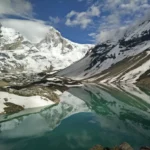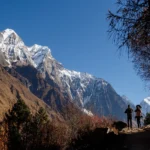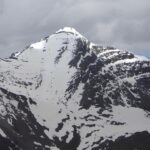Roopkund Lake and its mystery have intrigued every trekker to attempt the famous Roopkund Trek located in the Chamoli district of Uttarakhand. The Lake sits at an altitude of 16,470ft. above sea level. Roopkund Lake remains frozen for most of the year and is surrounded by rock-strewn glaciers. Also known as the Skeleton Lake of India, it is around 40 metre in diameter and 2 metre deep. Surrounded by snowclad mountains, one needs to traverse a steep descent to reach Roopkund, colloquially called the Lake of Skeletons. This infamous skeleton lake lies in the lap of Mt. Trishul Massif.
Why is Roopkund Lake called the Skeleton Lake of India?
The skeletons discovered by the lake remain confounding. A glacial lake located at 16000ft amidst the Himalayas has remained a subject of intrigue for travellers, researchers, and scientists. Roopkund Lake came to prominence when more than 500 human skeletons were discovered at the edge of the lake in the 1940s. The discovery of these skeletons earned the lake its name, the Skeleton Lake, or the Lake of Skeletons.
Both national and international teams of scientists and researchers have conducted extensive research on these human remains over the years. However, there has been no common conclusion.
Roopkund Lake and the Mystery of Human Skeletons
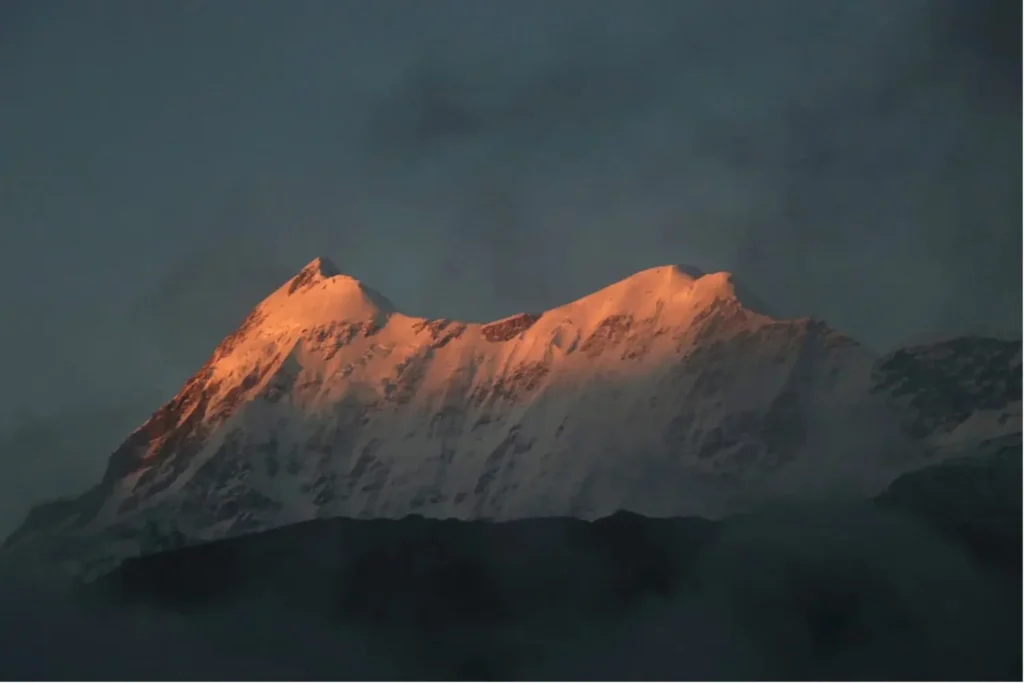
The Roopkund Lake is shrouded in mysteries and theories of all kinds. Different theories endeavour to explain the human skeletons at 16000 ft above sea level. The human skeletons first came to prominence in September 1942. A forest ranger who was on an assignment to study flowers growing in the region. He stumbled upon the hundreds of human skeletons in the vicinity of Roopkund Lake. along with these ghastly skeletons, Madahawal, and his team also discovered other artefacts around these bodies. Leather slippers, wooden utensils, and countrymade umbrellas were also discovered alongside the bodies.
The 1942 expedition to Roopkund followed teams of scientists and researchers frequenting the lake. The teams tried to study and discover the reasons behind the existence of the uncanny skeletons at 5000mt.
Roopkund Lake and its unsolved theories
Some believe the remains of the bodies by the Roopkund Lake were caused by an epidemic. While there was also an initial assumption stating that these bodies belonged to Japanese soldiers trying to sneak in. The skeletons were also assumed to be of Tibetan traders using the Silk Route. These theories were overruled by the research that followed in the later years.
The locals believe the skeletons to be of pilgrims part of a royal procession. At the base camp, Lohajung, locals will indulge you in fascinating folklore revolving around Roopkund Lake.
One mystery, many theories
The story talks about how enraged Nanda Devi, a locally revered deity, struck the royal group with large hailstones. A traditional song from the region talks of the ‘iron balls’ that killed the royal procession on pilgrimage to goddess Nanda Devi. The king was reckless and tainted the sanctity of the holy land. They believe the royal entourage met an unfortunate fate as the procession defiled the holy land by bringing the dancing troupe. The king was believed to have forgotten to offer prayer to Nanda Devi. As he remained engrossed in royal dancers ignoring the deity, his entourage perished in the hailstorm caused by the goddess.
Some believe the remains to be of pilgrims who were on Nanda Devi Raj Jat Yatra, a once-in-a-12-year Hindu pilgrimage. The pilgrimage, an ancient tradition continues to this day. Roopkund Lake is on the way to Homkund where the holy pilgrimage culminates.
Another version of stories circulated by the locals is about a queen. The queen who was pregnant participated in the pilgrimage. The queen delivered a baby in the holy land, tainting the pious place. This incident infuriated the goddess and he caused a violent snowstorm killing the entire entourage.
The Lost Soldiers
Another theory also talks about the bodies of King Zorawar Singh’s army who lost their way in the Himalayas while returning from the Battle of Tibet in the 1800s. This theory was defied a few years later when the study was conducted in the 1960s.
While different and intriguing versions of Roopkund Lake skeletons do a round, the lake’s nomenclature has a mythological origin. The villagers recall how their ancestors told them the story of Lord Shiva. Legend has it that Lord Shiva created the lake for his wife goddess Paravati. The goddess was returning after her victory over demons and wished to clean herself. Lord Shiva created a Kund or a lake to cater to her demands. As Parvati witnessed the reflection of her roop or beauty in the lake, it earned the name Roopkund. There is no end to mysteries and stories revolving around the mysterious Roopkund Lake.
Roopkund Lake: The findings
Since the alarming discovery of human skeletons, there have been a series of attempts to unravel the mystery of more than 800 human skeletons. However, the mystery of the Roopkund Lake remains unsolved and unanswered.
DNA studies conducted in the early 2000s suggest the skeletons be of South Asian ancestry. Radiocarbon dating found the skeletons belonged to around 800 A.D.
More recent studies of the site have established a completely different narrative around the skeleton lake of India. The report published in 2019 found the skeletons belonged to three genetically distinct groups. The team conducted full genomic and biomolecular analyses from 38 sets of skeletal remains. The studies conducted in labs worldwide found a group of 23 individuals with South Asian ancestry, and another cluster of 14 individuals to be of Mediterranean origin. The report also identified one individual with Southeast Asian-related ancestry. The findings stunned the world. It was revealed that these skeletons were deposited by the lake over 1000 years ago and across multiple events.
Roopkund Lake Trek
Every year hundreds of trekkers attempt to complete the challenging Roopkund Lake trek that starts from a village called Lohajung. The Roopkund Trek is around 53 km long and spreads over 8 days. The trek takes you to an altitude of 5,029 meters.
Roopkund has been shrouded in mysteries with no common conclusion. However, the trek to this mystery lake of Roopkund is full of adventure, mysteries, mountains, and exotic meadows. The tales of mysteries begin right from the villages you traverse through. The trekkers witness the beguiling meadows of Ali and Bedni, the towering Mt. Trishul in its full glory, and the ghastly scene of human skeletons on the edge of the lake.
Check out our dates for the Roopkund Trek here.
Why Roopkund Lake Trek should be on your bucket list
While the Roopkund trek remains engulfed in a series of mysteries, trekkers from across the world undertake the trek and are enamoured by the unprecedented beauty of the Himalayas. Many are curious about the skeletal remains by the lake and often return enchanted by the mesmerizing vistas they experience on the Roopkund trek.
Enchanting forest trail
Roopkund Lake trek takes you through deep forests enwrapped in Rhododendron and Oaks forests. The trail is ethereal, captivating you with its dreamlike serenity.
The walk along the forests of Ghairoli Patal suddenly burst into the enormous meadows of Ali and Bedni Bugyal.
The beauty of Ali Bedni Bugyal
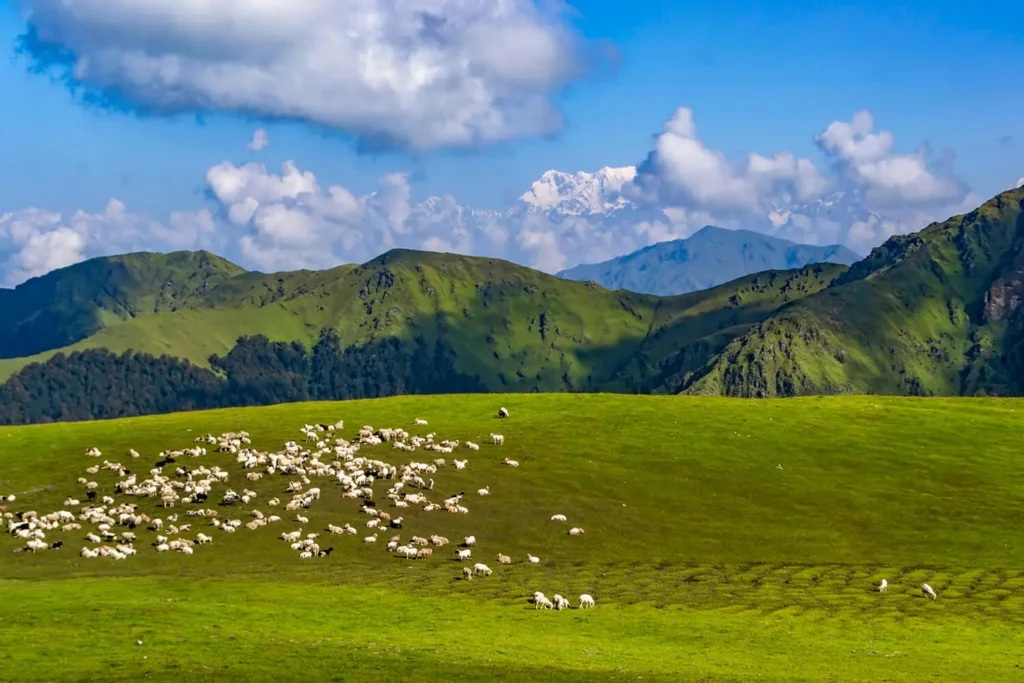
The Ali Bedni Bugyal offers a panoramic view of the most stunning high-altitude meadows in our country. In summer, the meadow of Ali Bedni is covered with scintillating wildflowers blooming in different shades. The grasslands compel you to enjoy its softness barefoot.
With beautiful rolling meadows, never-ending alpine stretches, steep climbs, and fun descents, this trek offers a gamut of experiences r. As you make your way toward Junargali, the ridge walk is a spine-chilling experience you can count on for that added adrenaline rush!
The intriguing locals
The local people are ever so enthusiastic to regale travellers with the various facts and rumours about the Roopkund Lake, or more popularly the Skelton Lake – a subject of tremendous interest to scientists and historians who seek to find a conclusion.
Majestic Mountain Views
Besides the mysterious stories and folklore, the Roopkund Lake trek rewards you with the panoramic spectacle of the majestic Mt. Trishul and Mt. Nanda Ghunti awaiting you in all their glory. For a second, you’ll feel like you can almost touch them.
Allow yourself to be engulfed in this experience of mysteries, meadows, and mountains. Not every day do you get to be on a trek so spectacularly ethereal and rewarding in all its glory and tradition.
Recommended for seasoned trekkers
As intriguing as it sounds, the Roopkund Lake trek is not suitable for beginners. The trek takes you from 8000ft to 16000ft in six days. The Roopkund trek is suggested for trekkers with prior high-altitude trekking experience. As you traverse on tricky patches and challenging trails, the trek demands physical and mental strength. As you gain considerable altitude, there are also chances of AMS and altitude-related problems.
Roopkund Lake Trek is for you if you are looking for an intriguing Himalayan trek. The one where you will witness the majestic mountains, enthralling forest trails, and stories in abundance.
Join us this summer for the famous Roopkund Lake trek or Skeletons Lake trek in Uttarakhand. Check out our dates for the Roopkund Lake trek here.

